As an Amazon Associate I earn from qualifying purchases.
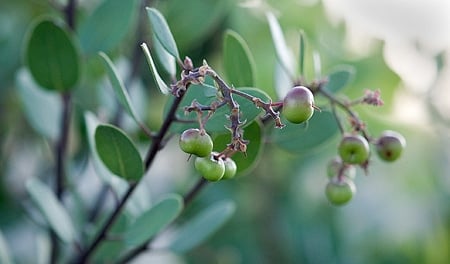
If you live in the West, you’ve seen the mystical manzanita: It is a captivating shrub, if such a thing can be said with a straight face.
Manzanita leaves are perfect ovals, thick to hold in moisture and colored a luminous, silvery green; under the full moon, the leaves glow eerily. But it’s the wood that is so unique: Bright red and gnarled, when the bush grows into its adulthood, its bark will burst and flake off like the aftermath of a bad sunburn.
Come upon a manzanita in spring and you could be forgiven for mistaking it for a weird blueberry bush. It’s not, as manzanita is in the arctostaphylos, not the vaccinium clan, but both shrubs have very similar urn-shaped flowers.
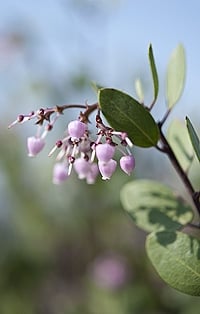
Come upon a manzanita later in summer and you will understand its name: Manzanita means “little apple” in Spanish. Look at the top picture: They really do look like little apples.
Ever since I moved to California I’d read that the berries were quasi-edible, that someone — Indians or Spaniards — did something with them at some point. I even bought a couple of manzanita bushes to plant in that blast furnace I call my front yard. But I bought them because manzanita is a beautiful bush, not because I had designs on the berries.
That was a decade ago. My bushes are big and beautiful, and they set many hundreds of “little apples” every year. What to do with them? As it happens, the Franciscan friars, who were the first European settlers of California, made a sort of cider from the berries. The California Indians did the same thing, plus they made a meal from the dried, ripe berries they’d later use for porridge in winter.
Cider, eh? I like cider. But really? I’d eaten a berry or two, and I can tell you manzanita is definitely not something to munch on while walking a trail. The unripe berries are loaded with tannin, which sucks all the moisture from your mouth and replaces it with a coating of felt — or at least it feels that way. The red berries do get nice and sweet, but they are powdery dry and you need to not eat the seeds, which are hard as rocks; the powder does remind of of Pixie Stix from my childhood, though…
There is very little information on manzanita as an edible plant. Charlotte Bringle Clarke mentions it in her excellent book Edible and Useful Plants of California, as does Sylvia Ross in her book Seaweed, Salmon, and Manzanita Cider: A California Indian Feast.
Opinions and instructions vary wildly. Best I can suss out, the Spaniards liked the berries greenish, while the Indians waited until they were brown and dry. Being of European descent, I decided on picking my manzanita berries green, but with a little rosy blush on them.
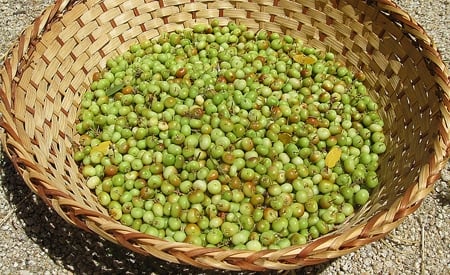
I got four cups from one bush, and I did not even pick it clean. Definitely enough to play with.
The berries are dry. So I first decided to boil them for 20 minutes, then smash them with a potato masher. I then let this cool overnight and poured it into a Mason jar. I let the solids settle for a day. Next day I poured off the liquids through cheesecloth into a clean Mason jar. I noticed a lot of fine sludge. I tasted it. Ack! Pure tannin, dry and bitter.
I tasted the cider. Um, ick. It was just like the sludge. Undrinkable. But, there was hope embedded in the loss: I could definitely taste an apple-y, acidic flavor that was indeed tasty — before the tannins clubbed me in the forehead.
Back to the drawing board. I thought, hmmm… If you boil sumac, you get the same bitterness. Sumac “lemonade” is made by just pouring room temperature water on the berries. Now manzanita is way too hard to do this, so I compromised by pouring boiling water on the berries, letting it steep for 20 minutes, and then smashing them with a potato masher.
After an overnight steep, I put everything back into a Mason jar.
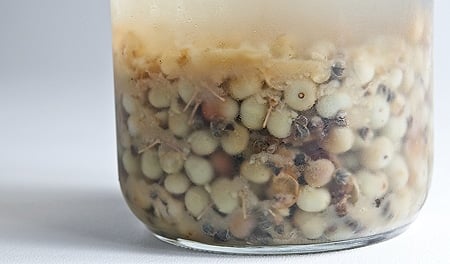
I strained this through cheesecloth and took a sip. Bingo! Light, crisp, just a tiny bit tannic, and even ever-so-slightly sweet. It tastes disturbingly like a non-carbonated hard cider or a Pinot Grigio, only without the alcohol. You can sweeten this if you’d like, but I like it as-is.
So, here’s what you need to know to make manzanita cider:
- For a white cider, pick the berries when they are blushing, late June in the lowlands, September in the high Sierra. You want them green with a bit of blush, at least where the berries have been exposed to the sun; berries in full shade won’t get the blush. For a pink cider, wait until the berries are fully red and dry.
- Wash the berries, which will be dusty and might have cobwebs and other debris on them.
- Your ratio is 1 cup manzanita berries to 4 cups water.
- Boil the water and pour it over the berries. Wait 20 minutes.
- Crush the berries with a potato masher. Don’t wail on them, just bruise and lightly break the berries.
- Let this steep at room temperature overnight.
- The next day, pour the cider through a fine sieve into a mason jar. Now do it again, this time through cheesecloth. Save the berries, because you can make another batch of cider with them. Now let your cider sit in the fridge overnight. More sediment will fall to the bottom. Carefully decant the good cider from the jar, leaving as much of the fine sediment in the original jar as possible. The sediment is loaded with tannins, so you want it out of your cider.
- Drink some. It will taste a little like a dry hard cider. Sweeten to taste for a cooling drink. I’ve added 2 tablespoons of sugar for every pint of cider, but I often just drink it plain.
Can you do something with manzanita cider other than drink it? You bet. Mix it with an equal volume of sugar to make manzanita syrup. You can then make ice cream, sorbet, or just use it as a concentrate for a cooling drink.
Where can you find manzanita? You’ll find these bushes growing in great profusion in the Sierra Nevada of California, but various species will grow as far north as British Columbia and as far east as Texas. They are, for the most part, lovers of arid places. It doesn’t matter which species you come across – all manzanita berries are edible. I should note that a few species of manzanita are endangered, so pick from large masses of the plants, not isolated individuals.
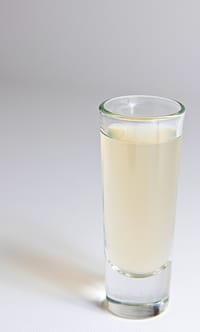
Is the drink worth this effort? I’d say yes. Manzanita is all over the place out there, and the berries store really well in the fridge, up to 2 months. Some will burst and release their little black seeds, but no biggie. I have had no mold problems, and the cider tasted just as good as when fresh-picked. The drink is really quite elegant-tasting. I’d be proud to serve it in a wineglass to someone who does not drink alcohol — or, for those who partake, mixed with vodka. Manza-tini, anyone?


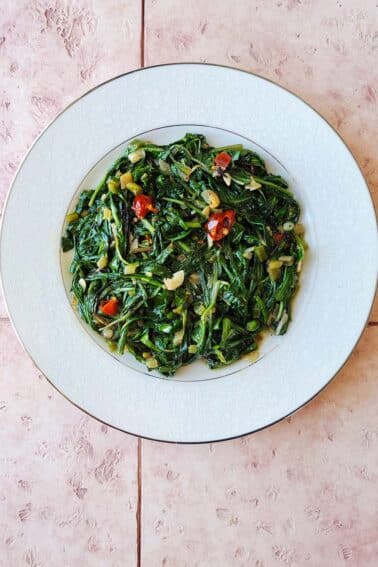
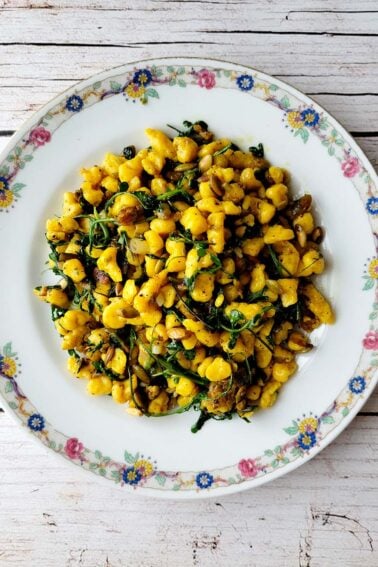
Did you not try making manzanita cider with ripened berries?
Donna: Sure, I do that, too. That’s a different recipe.
Thank you for the cidar recipe, I am going to work on this tonight! I am looking for a Manzanita Jelly recipe, does anyone know of one and if the berries are green or do you use the ripe berries? Any help would be great as we have over 20 LARGE Manzanitas on our land and I wanted to use some, but also leave plenty for the bears! We live in the Sierra foothills, so they do really well here, Mariposa to be exact! Thanks!
Hi Marie,
I have not tried making it but I did stumble across a recipe for manzanita jelly at https://www.bylt.org/youth-programs/wild-food-recipes/manzanita-blossoms/
I would love other variations if anyone has some!
Good luck!